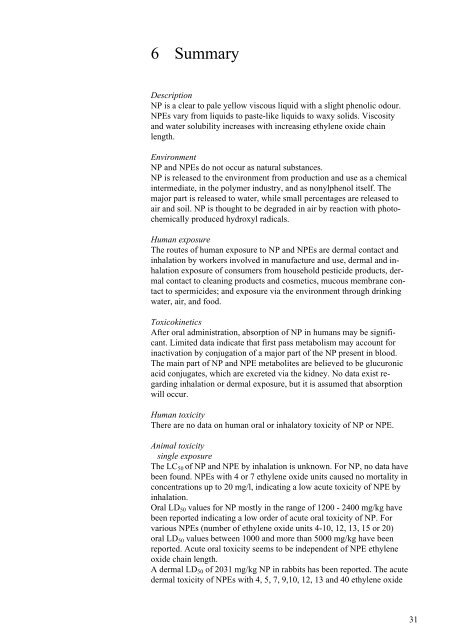Toxicological Evaluation and Limit Values for ... - Miljøstyrelsen
Toxicological Evaluation and Limit Values for ... - Miljøstyrelsen
Toxicological Evaluation and Limit Values for ... - Miljøstyrelsen
- No tags were found...
You also want an ePaper? Increase the reach of your titles
YUMPU automatically turns print PDFs into web optimized ePapers that Google loves.
6 SummaryDescriptionNP is a clear to pale yellow viscous liquid with a slight phenolic odour.NPEs vary from liquids to paste-like liquids to waxy solids. Viscosity<strong>and</strong> water solubility increases with increasing ethylene oxide chainlength.EnvironmentNP <strong>and</strong> NPEs do not occur as natural substances.NP is released to the environment from production <strong>and</strong> use as a chemicalintermediate, in the polymer industry, <strong>and</strong> as nonylphenol itself. Themajor part is released to water, while small percentages are released toair <strong>and</strong> soil. NP is thought to be degraded in air by reaction with photochemicallyproduced hydroxyl radicals.Human exposureThe routes of human exposure to NP <strong>and</strong> NPEs are dermal contact <strong>and</strong>inhalation by workers involved in manufacture <strong>and</strong> use, dermal <strong>and</strong> inhalationexposure of consumers from household pesticide products, dermalcontact to cleaning products <strong>and</strong> cosmetics, mucous membrane contactto spermicides; <strong>and</strong> exposure via the environment through drinkingwater, air, <strong>and</strong> food.ToxicokineticsAfter oral administration, absorption of NP in humans may be significant.<strong>Limit</strong>ed data indicate that first pass metabolism may account <strong>for</strong>inactivation by conjugation of a major part of the NP present in blood.The main part of NP <strong>and</strong> NPE metabolites are believed to be glucuronicacid conjugates, which are excreted via the kidney. No data exist regardinginhalation or dermal exposure, but it is assumed that absorptionwill occur.Human toxicityThere are no data on human oral or inhalatory toxicity of NP or NPE.Animal toxicitysingle exposureThe LC 50 of NP <strong>and</strong> NPE by inhalation is unknown. For NP, no data havebeen found. NPEs with 4 or 7 ethylene oxide units caused no mortality inconcentrations up to 20 mg/l, indicating a low acute toxicity of NPE byinhalation.Oral LD 50 values <strong>for</strong> NP mostly in the range of 1200 - 2400 mg/kg havebeen reported indicating a low order of acute oral toxicity of NP. Forvarious NPEs (number of ethylene oxide units 4-10, 12, 13, 15 or 20)oral LD 50 values between 1000 <strong>and</strong> more than 5000 mg/kg have beenreported. Acute oral toxicity seems to be independent of NPE ethyleneoxide chain length.A dermal LD 50 of 2031 mg/kg NP in rabbits has been reported. The acutedermal toxicity of NPEs with 4, 5, 7, 9,10, 12, 13 <strong>and</strong> 40 ethylene oxide31
















